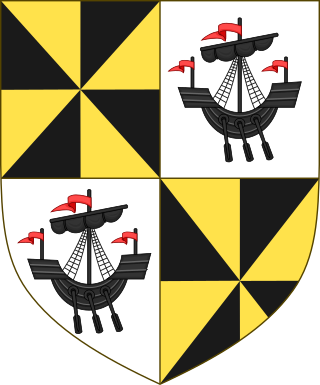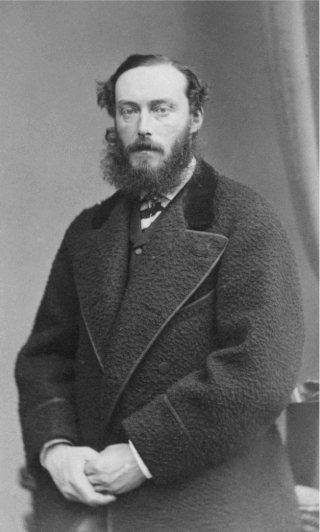Related Research Articles

Marquess of Aberdeen and Temair, in the County of Aberdeen, in the County of Meath and in the County of Argyll, is a title in the Peerage of the United Kingdom. It was created on 4 January 1916 for John Hamilton-Gordon, 7th Earl of Aberdeen.

Baron Moncreiff, of Tulliebole in the County of Kinross, is a title in the Peerage of the United Kingdom. It was created on 9 January 1874 for the lawyer and Liberal politician Sir James Moncreiff, 1st Baronet. He had already been created a Baronet, of Kilduff in the County of Kinross, in the Baronetage of the United Kingdom on 23 May 1871. In 1883 Lord Moncreiff also succeeded his elder brother as 11th Baronet, of Moncreiff in the County of Perth. On his death the titles passed to his eldest son, the second Baron. He was a Judge of the Court of Session from 1888 to 1905 under the title of Lord Wellwood and served as Lord Lieutenant of Kinross-shire between 1901 and 1909. He was succeeded by his younger brother, the third Baron. He was a clergyman. As of 2010 the titles are held by the latter's great-grandson, the sixth Baron, who succeeded his father in 2002.

Gillespie Archibald Campbell, 2nd Earl of Argyll was a Scottish nobleman and politician who was killed at the Battle of Flodden.
Sir James Angus Rhoderick Neil McGrigor, 6th Baronet is a Scottish Conservative Party politician, who is a councillor in Argyll and Bute. He had previously been a Member of the Scottish Parliament (MSP) for the Highlands and Islands region from 1999 until 2016.

Clan Lamont is a Highland Scottish clan. The clan is said to descend from Ánrothán Ua Néill, an Irish prince of the O'Neill dynasty, and through him Niall Noigíallach, High King of Ireland. Clan Ewen of Otter, Clan MacNeil of Barra, Clan Lachlan, and Clan Sweeney are also descendants of Ánrothán. Traditional genealogy would therefore include Clan Lamont among the descendants of Conn Cétchathach.

There have been three baronetcies created for members of the Grey family, one in the Baronetage of England, one in the Baronetage of Great Britain and one in the Baronetage of the United Kingdom. Two of the creations are extant as of 2007.
The Orde, later Campbell-Orde Baronetcy, of Morpeth in the County of Northumberland, is a title in the Baronetage of Great Britain. It was created on 9 August 1790 for the naval commander John Orde. He was the younger brother of Thomas Orde-Powlett, 1st Baron Bolton. The third Baronet assumed in 1880 by Royal licence the additional surname of Campbell, which was that of his maternal grandfather Peter Campbell, of Kilmory.

Clan Riddell is a Scottish clan of the Scottish Lowlands.

John Douglas Edward Henry Campbell, 7th Duke of Argyll,, known as Lord John Campbell until 1839, was a Scottish peer and Whig politician.

There have been two baronetcies created for persons with the surname Maclean, one in the Baronetage of Nova Scotia and one in the Baronetage of the United Kingdom. Both creations are extant as of 2010.
There have been two baronetcies created for persons with the surname MacLeod, both in the Baronetage of the United Kingdom. As of 2014 both titles are extant.
Peers of the Realm have been associated with Australia since early in its history as a British settlement. Many peers served as governors of the Australian colonies, and in the days when the practice of appointing British governors-general was current, the great majority were peers.

Carter-Campbell of Possil is a branch of Clan Campbell, a Scottish clan. Historically, they are part of Clan Campbell, which was regarded as one of the largest Scottish clans. The branch of the Campbell clan was historically centred in Lawers. Some of the clan, which originated with the original Campbells, had links to the lands of Argyll.

The Campbell of Auchinbreck family was founded by Duncan Campbell in Glassary, Argyll, Scotland. He was the son of Lord Duncan Campbell, first Lord Campbell of the Clan Campbell, by his second wife Margaret, daughter of Sir John Stewart of Blackhall, the illegitimate son of King Robert III of Scotland. The family of the Lords Campbell later became Dukes of Argyll, and remain chiefs of Clan Campbell. Duncan Campbell, as a grandson of King Robert III, received a considerable estate confirmed by royal charter dated 19 June 1452. The family remained at their estate of Auchinbreck, from which they took their title, until 1641. The Campbells of Auchinbreck were commissioned to provide military training and were used by the Earls of Argyll as military support. In 1628 the then head of the family of Campbells in Auchinbreck received a baronetcy, which included a grant of North American land in Nova Scotia.

Sir Norman Lamont, 2nd Baronet was a Scottish Liberal Party politician, sugar planter in Trinidad, and a recognised authority on agriculture.
The 1905 Buteshire by-election was a by-election held on 3 March 1905 for the British House of Commons constituency of Buteshire.

James Lamont was a Scottish explorer and author, particularly known for his voyages in the Arctic in 1858–59 and 1869–71, which were the topic of his two books, Seasons with the Sea-Horse (1861) and Yachting in the Arctic Seas (1876). He was a fellow of the Geological Society of London and the Royal Geographical Society. He served as the Liberal Member of Parliament for Buteshire (1865–68), and was created a baronet in 1910.
James Lamont may refer to:
John Lamont from Inverchaolain, by Toward in Cowal, emigrated from Scotland in 1801 to Trinidad where he served his apprenticeship as an overseer and manager on a sugar plantation. He purchased his own estates, and became a wealthy sugar planter. From 1828 he made annual visits back to Scotland, and bought Benmore Estate in 1849 for his nephew James Lamont, but died in 1850 before planned construction of the new Benmore House was completed. The house is now an outdoor education centre in Benmore Botanic Garden.
References
- ↑ A. G. E. Jones (2014) [2004]. Lamont, Sir James, first baronet (1828–1913) Oxford Dictionary of National Biography , Oxford University Press doi : 10.1093/ref:odnb/46828
- ↑ Argyll Laird Dead. Gored by Bull on Trinidad Estate. Sir Norman Lamont. The Scotsman , p. 6 (6 September 1949) (courtesy link; archived 13 July 2011)